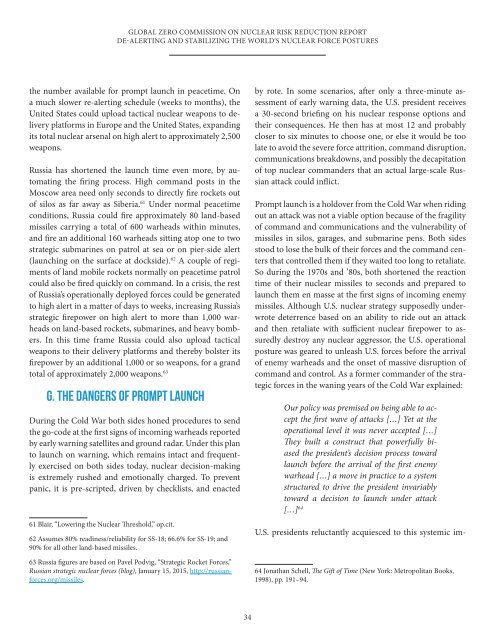global_zero_commission_on_nuclear_risk_reduction_report
global_zero_commission_on_nuclear_risk_reduction_report
global_zero_commission_on_nuclear_risk_reduction_report
You also want an ePaper? Increase the reach of your titles
YUMPU automatically turns print PDFs into web optimized ePapers that Google loves.
GLOBAL ZERO COMMISSION ON NUCLEAR RISK REDUCTION REPORTDE-ALERTING AND STABILIZING THE WORLD’S NUCLEAR FORCE POSTURESthe number available for prompt launch in peacetime. Ona much slower re-alerting schedule (weeks to m<strong>on</strong>ths), theUnited States could upload tactical <strong>nuclear</strong> weap<strong>on</strong>s to deliveryplatforms in Europe and the United States, expandingits total <strong>nuclear</strong> arsenal <strong>on</strong> high alert to approximately 2,500weap<strong>on</strong>s.Russia has shortened the launch time even more, by automatingthe firing process. High command posts in theMoscow area need <strong>on</strong>ly sec<strong>on</strong>ds to directly fire rockets outof silos as far away as Siberia. 61 Under normal peacetimec<strong>on</strong>diti<strong>on</strong>s, Russia could fire approximately 80 land-basedmissiles carrying a total of 600 warheads within minutes,and fire an additi<strong>on</strong>al 160 warheads sitting atop <strong>on</strong>e to twostrategic submarines <strong>on</strong> patrol at sea or <strong>on</strong> pier-side alert(launching <strong>on</strong> the surface at dockside). 62 A couple of regimentsof land mobile rockets normally <strong>on</strong> peacetime patrolcould also be fired quickly <strong>on</strong> command. In a crisis, the restof Russia’s operati<strong>on</strong>ally deployed forces could be generatedto high alert in a matter of days to weeks, increasing Russia’sstrategic firepower <strong>on</strong> high alert to more than 1,000 warheads<strong>on</strong> land-based rockets, submarines, and heavy bombers.In this time frame Russia could also upload tacticalweap<strong>on</strong>s to their delivery platforms and thereby bolster itsfirepower by an additi<strong>on</strong>al 1,000 or so weap<strong>on</strong>s, for a grandtotal of approximately 2,000 weap<strong>on</strong>s. 63G. THE DANGERS OF PROMPT LAUNCHDuring the Cold War both sides h<strong>on</strong>ed procedures to sendthe go-code at the first signs of incoming warheads <strong>report</strong>edby early warning satellites and ground radar. Under this planto launch <strong>on</strong> warning, which remains intact and frequentlyexercised <strong>on</strong> both sides today, <strong>nuclear</strong> decisi<strong>on</strong>-makingis extremely rushed and emoti<strong>on</strong>ally charged. To preventpanic, it is pre-scripted, driven by checklists, and enacted61 Blair, “Lowering the Nuclear Threshold,” op.cit.62 Assumes 80% readiness/reliability for SS-18; 66.6% for SS-19; and90% for all other land-based missiles.63 Russia figures are based <strong>on</strong> Pavel Podvig, “Strategic Rocket Forces,”Russian strategic <strong>nuclear</strong> forces (blog), January 15, 2015, http://russianforces.org/missiles.by rote. In some scenarios, after <strong>on</strong>ly a three-minute assessmentof early warning data, the U.S. president receivesa 30-sec<strong>on</strong>d briefing <strong>on</strong> his <strong>nuclear</strong> resp<strong>on</strong>se opti<strong>on</strong>s andtheir c<strong>on</strong>sequences. He then has at most 12 and probablycloser to six minutes to choose <strong>on</strong>e, or else it would be toolate to avoid the severe force attriti<strong>on</strong>, command disrupti<strong>on</strong>,communicati<strong>on</strong>s breakdowns, and possibly the decapitati<strong>on</strong>of top <strong>nuclear</strong> commanders that an actual large-scale Russianattack could inflict.Prompt launch is a holdover from the Cold War when ridingout an attack was not a viable opti<strong>on</strong> because of the fragilityof command and communicati<strong>on</strong>s and the vulnerability ofmissiles in silos, garages, and submarine pens. Both sidesstood to lose the bulk of their forces and the command centersthat c<strong>on</strong>trolled them if they waited too l<strong>on</strong>g to retaliate.So during the 1970s and ’80s, both shortened the reacti<strong>on</strong>time of their <strong>nuclear</strong> missiles to sec<strong>on</strong>ds and prepared tolaunch them en masse at the first signs of incoming enemymissiles. Although U.S. <strong>nuclear</strong> strategy supposedly underwrotedeterrence based <strong>on</strong> an ability to ride out an attackand then retaliate with sufficient <strong>nuclear</strong> firepower to assuredlydestroy any <strong>nuclear</strong> aggressor, the U.S. operati<strong>on</strong>alposture was geared to unleash U.S. forces before the arrivalof enemy warheads and the <strong>on</strong>set of massive disrupti<strong>on</strong> ofcommand and c<strong>on</strong>trol. As a former commander of the strategicforces in the waning years of the Cold War explained:Our policy was premised <strong>on</strong> being able to acceptthe first wave of attacks […] Yet at theoperati<strong>on</strong>al level it was never accepted […]They built a c<strong>on</strong>struct that powerfully biasedthe president’s decisi<strong>on</strong> process towardlaunch before the arrival of the first enemywarhead […] a move in practice to a systemstructured to drive the president invariablytoward a decisi<strong>on</strong> to launch under attack[…] 64U.S. presidents reluctantly acquiesced to this systemic im-64 J<strong>on</strong>athan Schell, The Gift of Time (New York: Metropolitan Books,1998), pp. 191–94.34


